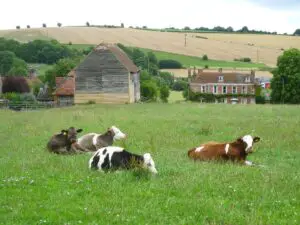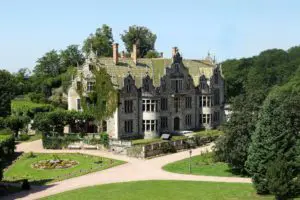
FULL POEM - SCROLL DOWN FOR LINE-BY-LINE ANALYSIS
[Which way do we face to talk to the dead?]
Dedicated to: Rainer Maria Rilke
My father’s face
five days dead
is organised for me to see.
It’s cold in here
and the borrowed coffin gleams unnaturally;
the pine one has not yet been delivered.
Half-expected this inverted face
but not the soft, for some reason
unfrozen collar of his striped pyjamas.
This is the last time I am allowed
to remember my childhood as it might have been:
a louder, braver place,
crowded, a house with a tin roof
being hailed upon, and voices rising,
my father’s wry smile, his half-turned face.
My father would not show us how to die.
He hid, he hid away.
Behind the curtains where his life had been,
the florist’s flowers curling into spring,
he lay inside, he lay.
He could recall the rag-and-bone man
passing his mother’s gate in the morning light.
Now the tunnelling sound of the dogs next door;
everything he hears is white.
My father could not show us how to die.
He turned, he turned away.
Under the counterpane, without one call
or word or name,
face to the wall, he lay.

LINE-BY-LINE ANALYSIS
STANZA 1
[Which way do we face to talk to the dead?]
The sub-title quotes Rainer Maria Rilke’s ‘Requiem for a Friend’.
Dedicated to: Rainer Maria Rilke
My father’s face
five days dead
The poem begins ‘in media res’ due to the fact that the narrative begins once the man is already dead without taking us on a journey of his closing moments and its present tense nature. This at odds with the title being in past tense which suggested the poem would take a reflective tone.
is organised for me to see.
The word ‘organised’ implies that the body has been altered and arranged to allow her to view his body. This intervention is similar in nature to the divine, powerful intervention of death.
STANZA 2
It’s cold in here
The speaker goes onto describe the room she is viewing the body in. The ‘Cold’ is a pathetic fallacy for the prominence of death throughout the poem. De Kok creates a supernatural image of death and the coldness associated with it radiating from the corpse of the man.
and the borrowed coffin gleams unnaturally;
It’s unusual to label a ‘coffin’ as ‘borrowed’ as one wouldn’t think of a coffin as a reusable entity. Perhaps de Kok creates this uncertainty purposely to contrast the permanency of death. The adjective ‘unnaturally’ signifies a disparity between the living image of light ‘gleaming’ off the symbol of death that is the ‘coffin’.
the pine one has not yet been delivered.
This line acts almost as an afterthought – a seemingly extraneous comment. However, its ordinary nature serves to make his death seem more real.
STANZA 3
Half-expected this inverted face
The speaker explains that she expected to be ‘inverted’. This suggests that his face is disfigured and this disfigurement is heightened as ‘inverted’ implies that his face is opposite to before.
but not the soft, for some reason
unfrozen collar of his striped pyjamas.
The speaker didn’t expect to see his ‘soft’ ‘pyjamas’ with their ‘unfrozen collar’. These are comforting, sensory images that juxtapose the coldness of the room and his body as well as his disfigured face. This surprises the speaker.
STANZA 4
This is the last time I am allowed
to remember my childhood as it might have been:
a louder, braver place,
These are 3 emotive lines, as the speaker contemplates the ‘louder’ and ‘braver’ childhood that she missed out on after their father’s death. Its emotion derives not only from the loss of her father but the ‘louder, braver’ life she lost. ‘Remember’ seems an odd word choice as these events never actually happened but it further highlights the memories as well as experiences and father they’re mourning.
crowded, a house with a tin roof
being hailed upon, and voices rising,
my father’s wry smile, his half-turned face.
These 3 lines are an anecdote from the childhood of the speaker when they’re father was alive. The security the child feels juxtaposes the imposing storm, further emphasizing the sense of security that the father shared.
STANZA 5
My father would not show us how to die.
This line links to the idea of a father-figure teaching and acting as an inspiration to his children. De Kok explores how he acts as a paternal role-model and by being with his children in his dying moments he would be showing them how to die, just like how a father taught his kids how to ride a bike.
He hid, he hid away.
The man ‘hid away’ to conceal his death from his children for the aforementioned reason and to save them from the trauma. It is evident that the man expected his death.
Behind the curtains where his life had been,
The image of the ‘curtains’ further symbolisms how the man concealed his death from his children. ‘Curtains’ also describes him having a healthy façade in front of the curtain and the real reality of illness ‘where his life had been’.
the florist’s flowers curling into spring,
The imagery of the ‘flowers curling into spring’ juxtaposes the traditional metaphorical meaning of ‘spring’ in literature which is of new life and beginnings. The ‘curling’ of the flowers juxtaposes the buds of flowers opening in spring. The pathetic fallacy of new life also juxtaposes the man’s death.
he lay inside, he lay.
This mirrors but doesn’t repeat the previous line of ‘He hid, he hid away’. The subtle difference articulates the process of his death. It started off as him just ‘hiding’ but as his illness progressed he not only ‘hid’ but was forced to ‘lay’.
STANZA 6
He could recall the rag-and-bone man
The speaker focuses on the man reminiscing about his childhood. A ‘rag-and-bone man’ is a person who travels around an area buying old or unwanted clothes and household items in order to sell them on. The significance of this memory is to portray his nostalgia on his death bed. The image of poverty also links to the poverty of death – in this case, minutes of life are the scarce commodity.
passing his mother’s gate in the morning light.
The description of ‘his mother’ is also nostalgic and illustrates a kind of demise for him as he goes back to relying on the stereotypical comfort of his mother as children do for comfort.
Now the tunnelling sound of the dogs next door;
There’s a shift from the sense of sight to sound. It shows that the man is interacting with the world through sound now and not sight, which paints a picture of him locked up in a room alone with muffled sounds his only connection to the outside world.
everything he hears is white.
This line creates an overwhelming feeling, as though everything he hears is coming together and just merging into one creating indistinguishable ‘white’ noise – further disconnecting him from the world.
STANZA 7
My father could not show us how to die.
He turned, he turned away.
Under the counterpane, without one call
or word or name,
face to the wall, he lay


